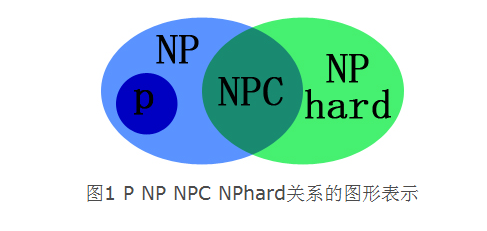1、首先涉及到的基本概念有:
(1)确定性算法(Determinism): 设A是问题Π的一个解决算法,在算法的整个执行过程中,每一步都能得到一个确定的解,这样的算法就是确定性算法。
(2)非确定性算法(Nondeterminism):设A是求解问题Π的一个算法,它将问题分解成两部分,分别为猜测阶段和验证阶段,其中
- 猜测阶段:在这个阶段,对问题的输入实例产生一个任意字符串y,在算法的每一次运行时,串y的值可能不同,因此,猜测以一种非确定的形式工作。
- 验证阶段:在这个阶段,用一个确定性算法(有限时间内)验证:① 检查在猜测阶段产生的串y是否是合适的形式,如果不是,则算法停下来并得到no;② 如果串y是合适的形式,则验证它是否是问题的解,如果是,则算法停下来并得到yes,否则算法停下来并得到no。它是验证所猜测的解的正确性。
另外涉及到的概念有:
多项式时间(Polynomial):对于规模为n的输入,它们在最坏的情况下的运行时间为O(n^k),其中k为某个常数,则该算法为多项式时间的算法
在计算复杂度的理论中,算法的计算时间也就是时间复杂度m(n)不大于算法规模n的多项式倍数,也就是说m(n)是关于n的一个多项式函数。例如,时间复杂度为O(n^2)的就是多项式时间,而时间复杂度为O(2^n)的则不是关于n的多项式函数,因此就不是多项式时间。
- 1
- 2
- 3
2、P类问题,NP类问题,NP难问题,NPC问题
- (1)P类问题:在多项式时间内可解的问题。
- (2)NP类问题(Nondeterminism Polynomial):在多项式时间内“可验证”的问题。也就是说,不能判定这个问题到底有没有解,而是猜出一个解来在多项式时间内证明这个解是否正确。即该问题的猜测过程是不确定的,而对其某一个解的验证则能够在多项式时间内完成。P类问题属于NP问题,但不确定是否为NP问题的真子集。
- (3)NPC类问题(Nondeterminism Polynomial complete):存在这样一个NP问题,所有的NP问题都可以约化成它。换句话说,只要解决了这个问题,那么所有的NP问题都解决了。其定义要满足2个条件:
- 首先,它得是一个NP问题;
- 然后,所有的NP问题都可以约化到它。
- 要证明npc问题的思路就是:
- 先证明它至少是一个NP问题,
- 再证明其中一个已知的NPC问题能约化到它。
- (4)NP难问题(NP-hard问题):NP-Hard问题是这样一种问题,它满足NPC问题定义的第二条但不一定要满足第一条(就是说,NP-Hard问题要比
NPC问题的范围广,NP-Hard问题没有限定属于NP),即所有的NP问题都能约化到它,但是他不一定是一个NP问题。NP-Hard问题同样难以找到多项式的算法,但它不列入我们的研究范围,因为它不一定是NP问题。即使NPC问题发现了多项式级的算法,NP-Hard问题有可能仍然无法得到多项式级的算法。事实上,由于NP-Hard放宽了限定条件,它将有可能比所有的NPC问题的时间复杂度更高从而更难以解决。
以上四个问题他们之间的关系可以用下图来表示:
3、在2中涉及到的另外一个概念呢,就是:规约/约化
- 简单的说,问题A可以约化为问题B,就可以理解为:问题B的解就一定是问题A的解。
- 也可以理解为,“问题A可归约为问题B”,指问题B的答案可用于解决问题A。因此解决A不会难于解决B。
- 由此也可以知道的是问题B的时间复杂度一定会大于等于问题A。
- 《算法导论》上举了这么一个例子。比如说,现在有两个问题:求解一个一元一次方程和求解一个一元二次方程。那么我们说,前者可以规约为后者,意即知道如何解一个一元二次方程那么一定能解出一元一次方程。我们可以写出两个程序分别对应两个问题,那么我们能找到一个“规则”,按照这个规则把解一元一次方程程序的输入数据变一下,用在解一元二次方程的程序上,两个程序总能得到一样的结果。这个规则即是:两个方程的对应项系数不变,一元二次方程的二次项系数为0。
- 从规约的定义中我们看到,一个问题规约为另一个问题,时间复杂度增加了,问题的应用范围也增大了。通过对某些问题的不断规约,我们能够不断寻找复杂度更高,但应用范围更广的算法来代替复杂度虽然低,但只能用于很小的一类问题的算法。存在这样一个NP问题,所有的NP问题都可以约化成它。换句话说,只要解决了这个问题,那么所有的NP问题都解决了。这种问题的存在难以置信,并且更加不可思议的是,这种问题不只一个,它有很多个,它是一类问题。这一类问题就是传说中的NPC问题,也就是NP-完全问题。
转自willa要努力奋斗的博客:http://blog.csdn.net/u014295667/article/details/47090639























 9326
9326

 被折叠的 条评论
为什么被折叠?
被折叠的 条评论
为什么被折叠?








